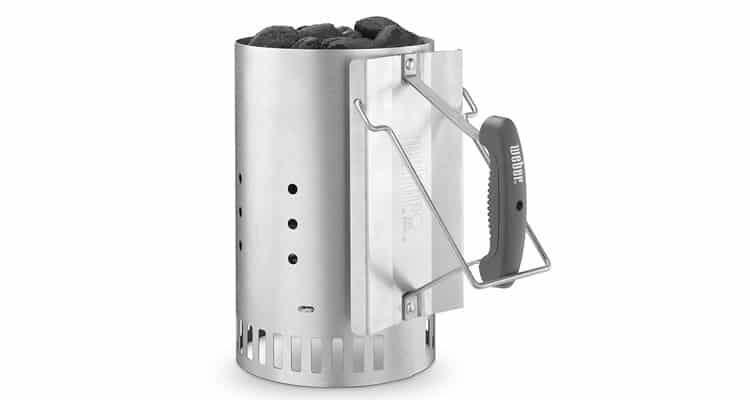The Weber Chimney Starter is a great way to start your charcoal without stinky lighter fluid quickly, toxic chemicals, a blow torch, costly starter sticks, or other incendiary magic.
Basically, a few sheets of newspaper at the bottom of the chimney creates a small fire which, through the magic of science, gets your coals rocket engine hot in just a few minutes. Faster, cleaner, and cheaper than other methods, it’s one of my favorite tools. So how does this thing work? In this article, I’ll not only tell you how well it works, but how it works.
The Weber Chimney Starter’s design and operation are deceptively simple. The bottom of the chimney has a series of concentric metal rings that form a funnel-shaped area. This area is designed to hold a couple of sheets of wadded-up newspaper, which will be used to get things going. On top of that, you fill-up the chimney with whatever fuel your using. I’ve used mine to start briquettes, natural lump charcoal, and mesquite chunks to great success. Then light the newspaper through one of the little vent holes in the bottom of the charcoal starter. Within about 3 minutes, you’ll start to see the flames peaking up through the top of your charcoal or wood chunks.
When things are really blazing and the topmost layer has fully caught, you’re ready to transfer your charcoal to the grill. Just use the little swing arm handle to empty your flaming charcoal into your grill. The handle has a heat-resistant plastic handle to keep it from getting too hot, but I still feel more comfortable using my welding gloves when dumping the charcoal into the grill.
So how does this simple device work Mr. Wizard? Its operation is based on the natural tendency of air to move from high to low pressures, a principle known as the chimney effect. The hot air from the burning newspaper rises naturally, producing air movement upwards through the chimney. As it rises through the constrained space of the chimney, the airspeed accelerates, lowering the pressure inside the chimney. This is called the Venturi effect, as you may remember from high school physics. This decrease in pressure, in turn, further accelerates the movement of the area, pulling hot air up through the fuel while simultaneously sucking in fresh air through the chimney’s bottom vents. This rapidly rising heat stack, combined with a continuous supply of new oxygen, creates, in essence, a miniature blast furnace.
[amazon box=”B07B5BHKDZ” link_id=”45″]
Related content you might like:
- 21 Best Small Gas Grills for 2024
- 15 Best 2-Burner Gas Grills for 2024
- 11 Best Pontoon Boat Grills for 2024
- 21 Best BBQ Grill Lights for 2024
- 10 Best Tailgating Grills – Tailgate Grill Reviews for 2024

